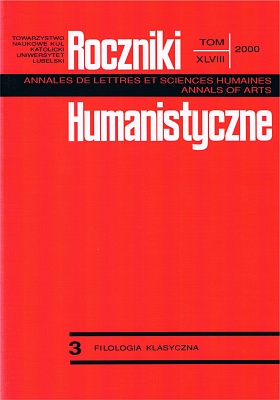Dostęp ikonografii do bóstwa według mitologii i filozofii greckiej oraz według Biblii
Abstrakt
Accessibility of iconography to God, iconography understood as the act of painting or sculpturing, depends on the degree of his attribute ἀπάϑεια and on the conception of his nature. The attribute ἀπάϑεια was ascribed to God by Greek philosophers. According to philological analysis ἀπάϑεια in the dimension of existence denotes not being in relation to anything; in the dimension of action – being intangible by anybody else's action, which is a consequence of the dimension of existence; and finally in the dimension of grammar – impossibility to be defined by any sentence, even syntactically active, and especially by a passive one.
By ascribing to God the attribute ἀπάϑεια Greek philosophers made it impossible to make his effigies. Moreover, their God is neither anthropomorphic nor zoomorphic or, indeed, personal. However, philosophers have generally accepted God's active and forming relation towards the visible world. According to them, nature is an epiphany of God's existence, acting and attributes. It follows then that iconography could try to show God but only in the form of an allegory, symbol, conventional sign or an artistic allusion.
Homer's religion encouraged art, especially sculpture, to present gods' and goddesses' effigies anthropomorphically. However, these effigies should show gods as ideally beautiful, young and full of dignity.
In the Bible God is a person and man is his visible image. Moreover, although the Bible contains the implicit notion of ἀπάϑεια as God's attribute, with its anthropomorphic pronouncements about God and with its whole contents it shows that God himself by his act of creation put himself in a relation to the world; that he removed the barrier of ἀπάϑεια, approaching man and treating him as his friend and ally. This gives iconography access to God. However, it was God's Son who validated it by becoming a real man with individual mental and bodily traits. Even though there are still very strict injunctions in the Bible not to make any effigies, from the time of the Son's incarnation they may be considered occasional, temporary, pedagogical-psychological, conditioned by the historical context.
And the Church has been following this interpretation. But has it been doing so without any reservations? God is only a spirit; but he remains an inconceivable mystery, and Christ is not only a man but also God. God cannot be fully experienced with the senses, comprehended with the reason, defined with the language or closed in space and time with a picture or sculpture. From this it follows that although the Church has accepted the iconography of God, the angels, the Virgin Mary and other saints, it still expects that the iconography should be Platonic in its spirit. Any effigy of God, or of Christ as God and man as well as any effigy of a saint should not rivet the gaze and thoughts of the man looking at it but it should lead this thought beyond time and space, i.e. to eternity; it should direct it to what is divine and not physical; it should incline one to contemplate God. Identification of the image with the presented person would be idolatry that is forbidden by God, but it would also be a mistake if a cult effigy only satisfied the sense of beauty and did not take one's thought to God.
Bibliografia
Burkert W.: Griechische Religion der archaischen und klassischen Epoche. Stuttgart 1977.
Encyklopedia Katolicka. T. 2: Bar − Centuriones. Pod red. F. Gryglewicza, R. Łukaszyka, Z. Sułowskiego. Lublin 1976.
Frisk H.: Griechisches etymologisches Wörterbuch. Bd. 1-3. Heidelberg 1960-1972.
Liddel H. G., Scott R.: A Greek-English Lexicon. Revised and augmented throughout by H. S. Jones with the assistance of R. McKenzie. With Supplement 1968. Ed. 9. Oxford 1940 (dodruk 1973).
Kozera M.: Ideały Ojców pustyni. Pathos i apatheia. Lublin 2000 s. 86 n.
Nilsson M. P.: Geschichte der griechischen Religion. Bd. 1: Bis zur griechischen Weltherrschaft. München 1941.
Peters F. E.: Greek Philosophical Terms. A Historical Lexicon. New York 1967.
Podsiad A., Więckowski Z.: Mały słownik terminów i pojęć filozoficznych dla studiujących filozofię chrześcijańską. Wprowadzenie A. Podsiad. Warszawa 1983.
Popowski R.: ᾽Απάϑεια Boga we wczesnochrześcijańskich wyznaniach wiary. (Zarys problemu). „Roczniki Humanistyczne” 44:1996 z. 3 s. 139-151.
Popowski R.: Dionizjos Trak i jego Gramatyka. „Roczniki Humanistyczne” 35:1987 z. 3 s. 59-71.
Popowski R.: Passivum w antycznej teorii helleńskiej. „Roczniki Humanistyczne” 30:1982 z. 3 s. 35-64;
Popowski R.: Stoicka teoria passivum i jej praktyczne zastosowanie wprzekładzie z języków klasycznych. W: Chrześcijańskie dziedzictwo bizantyńsko-słowiańskie. VI Kongres Teologów Polskich. Lublin 12-14 IX 1980. Red. ks. A. Kubiś, ks. M. Rusecki. Lublin 1994 s. 317-318.
Popowski R.: Sztuka w Credo. W: Symbol Apostolski w nauczaniu i sztuce Kościoła do Soboru Trydenckiego. Pod red. ks. R. Knapińskiego. Lublin 1997 s. 153-160.
Słownik grecko-polski. Pod red. Z. Abramowiczówny. T. 1-4. Warszawa 1958-1965.
Zdybicka Z.: [Bóg] w filozofii. W: Encyklopedia Katolicka. T. 2: Bar − Centuriones. Lublin 1976 szp. 917-919.
Zieliński T.: Religia starożytnej Grecji. Zarys ogólny. Przekład S. Srebrny. Religia hellenizmu. Przekład G. Piankówna. Wrocław 1991.
Zwolski E.: [Bóg] w religii greckiej. W: Encyklopedia Katolicka. T. 2: Bar − Centuriones. Lublin 1976 szp. 892-894.
Copyright (c) 2000 Roczniki Humanistyczne

Utwór dostępny jest na licencji Creative Commons Uznanie autorstwa – Użycie niekomercyjne – Bez utworów zależnych 4.0 Międzynarodowe.





